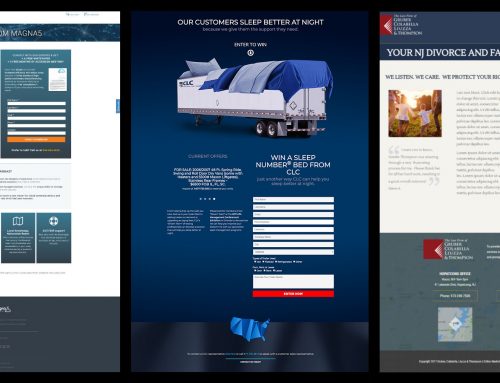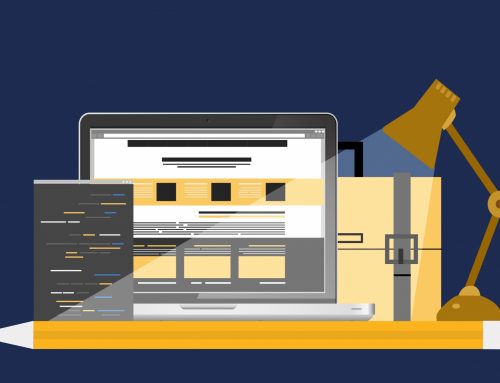When it comes to web design, there are definitely some deadly sins. Blinking text… Yellow-on-white text… Rainbow text… Comic Sans… Icons saying your site is best viewed in IE 5.5… That kind of stuff not only makes our skin crawl… it costs you money in lost leads. Your site may not be among the worst offenders, but it may not be on the straight & narrow either.
Your site should be an important gateway through which a continual stream of new leads (and sales, if it’s e-commerce) flows. But all too often, we see sites that are committing a few fundamental blunders that cause visitors who are ready & willing to engage to get frustrated and leave for a competitor.
Here are the 5 biggest no-no’s!
1) Who Ya Gonna Call?
Your visitors may be coming through the vast & anonymous web, but deep down, they still desperately want to speak to a human. They don’t want you to be a pushy salesperson, but they do want you to be highly accessible, so that they can easily talk to a real person whenever they’re ready.
So why is it so hard to find your phone number? We see sites every day that are hiding their digits, as if they don’t want the phone ringing off the hook with new leads. Repent! Place that number nice & prominently, in a tastefully large font, in your header on every page. And in your footer. And anywhere else that you’re calling the user to action.
It’ll communicate that you value customer service & that you’re a real & credible, accessible business. All good things.
This particular crime against humanity has a close cousin – buried, understated, or flat-out absent calls-to-action (CTA’s) and contact forms. We’ll dig into that one in a future post, but for now, suffice it to say – make it really easy for a user to get in touch or take a next step, whether electronically or on the phone.
2) What would you say… You do here?
Let us learn from “The Bobs.”* The vast majority of visitors to your site should be coming to you through search (and if that’s not true, you’re not doing enough SEO/SEM), and their primary mission is to find out whether you can help them in their moment of need. What your business does and how you solve the user’s problem should be immediately obvious.
Boil your value proposition down to a sentence, and place that sentence in plain view. Use design elements or an alluring typeface to draw the user’s eye to it. Keep your homepage clean & resist the urge to promote a lot of different content or make it so wordy that it’s a turn-off. Don’t get cute with bells & whistles or animations that take 20 seconds to get to the point.
Your homepage’s only goal is to make a great first impression and say “this is what we do and how we can help. Now click to the most relevant good or service.” Leave no doubt that the user has come to the right place.
* – If you don’t know “The Bobs,” stop reading right now and see the film Office Space. We’ll wait, and you’ll thank us.
3) Get Lost.
Many sites have navigation that’s either confusing, self serving, non-existent, or some combination thereof. It is sadly rare that we come across a site’s nav and think, “wow, they really thought this through.”
No navigation should be created until you’ve thoroughly considered your target markets and their needs, and crafted content that prioritizes and addresses their needs. Pages like “About us” are important. But in most cases, the user wants to know what you do, and if possible, how much it costs for you to do it, before they really care about your mission statement, company history, org chart, or employment opportunities. Don’t arrange your nav by your business sectors, don’t have 5 tiers of sub-navigation, don’t have 14 buttons in your main menu, and don’t let internal politics determine what section gets top billing.
Provide users clear, concise, and intuitive nav that guides them to the moment when they really want to submit an inquiry or pick up the phone.
4) I still haven’t found what I’m looking for
Few things fuel a person’s rage more than a search tool that gives irrelevant or unexpected results. Many sites we see with search tools shouldn’t even have one at all – either they have too little content to need one, or wouldn’t need one if their content was actually well organized. But too often, web developers treat a site’s search as an afterthought, don’t test it sufficiently, or don’t understand their content or users enough to connect the dots. And then your visitor comes to the site, types in their keyword, presses search… and curses the day they ever laid eyes on your business.
Think through whether you need a search at all. And if you do, invest the time and energy to craft it so that it will consistently generate highly relevant results that will fill your users’ hearts with joy and elation. Or be prepared for them to leave you for a competitor who treats them right.
5. Making Smartphones Groan
Some of you are thinking, “I don’t need a mobile site.” THAT IS CRAZY TALK. YES YOU DO.
Seriously, mobile users are comprising an ever-increasing percentage of your site’s visitors, and they tend to be far more ready than a desktop user to commit to an action step like, oh say, buying what you’re selling.
Even if your mobile traffic is low – say about 10%, for example – that’s the 10% who are most likely to become your customers. Don’t give them a bad experience or treat them like they’re not important. Don’t make them pull out an electron microscope in order to read your content. Don’t make them skip over giant white blocks where your awesome Flash animation from 2006 sits. Don’t make them sift through your full site map when all they care about is where you’re located and what number to call. Embrace them. Love them. Make them happy and cater to their every need. You will be rewarded.
Mobile optimized sites are crucial, cost effective, and bring enormous ROI. We’d rather create a mobile-optimized site for our clients – without a desktop version – than the other way around. It is that important.
So how’d you do?
We sincerely hope you and your site made it through the post unscathed. but if not, you need to understand that you have mission-critical, fatal flaws that must be addressed. Fix the issues, and the site can enjoy constant success, creating leads and generating revenue like Adam‘s favorite team, the Yankees. Leave things as-is, and it will be a perennial disappointing bottom feeder that is a big waste of money, like my favorite team, the Mets.
Let us know if we can help out. We’ll give you sage advice, a free estimate, and get you excited about what your website can do for your business.
About the author : Lance Miller
Join our mailing list today
Insider offers & flash sales in your inbox every week.
[fusion_form form_post_id="2830" hide_on_mobile="small-visibility,medium-visibility,large-visibility" class="" id="" /]
Curabitur non nulla sit amet nisl tempus convallis quis ac lectus dolor sit amet, consectetur adipiscing elit sed porttitor lectus.




